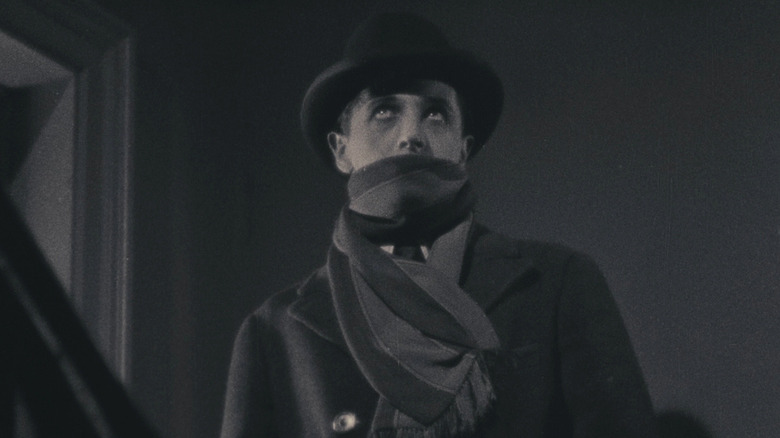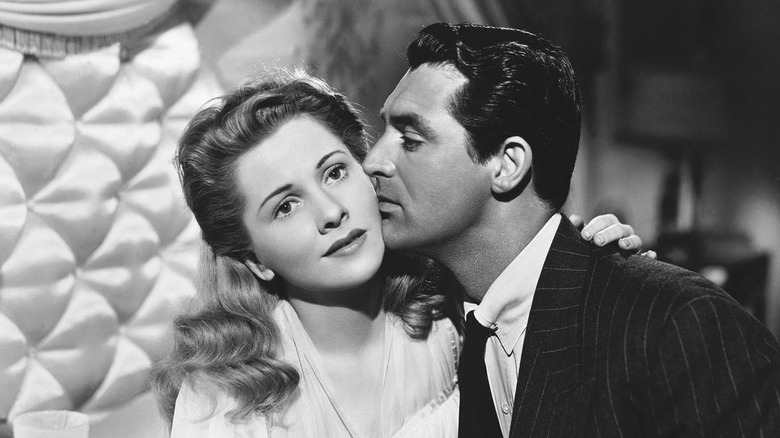Alfred Hitchcock's First True 'Hitchcock Movie' Faced A Studio Problem He'd See Again
In the seminal book "Hitchcock/Truffaut" — a collection of interviews with the Master of Suspense Alfred Hitchcock, conducted by celebrated filmmaker Francois Truffaut — the "Psycho" director looks back on one of his earlier works to identify a studio insistence that let the oxygen out of his creative tank, repeatedly.
According to the book, Hitchcock considers "The Lodger" his "first true Hitchcock movie." Adapted from Marie Belloc Lowndes' 1913 novel of the same name, the British 1927 adaptation surrounds Mrs. Bunting (Marie Ault), a London landlady whose daughter Daisy (June Tripp) is a blonde fashion model, the type targeted by a Jack the Ripper-esque killer known as the Avenger, who just claimed a seventh victim. As the murders continue, the primary suspect becomes her lodger, one Jonathan Drew (Ivor Novello).
The film's climax enmeshes the audience into a mob that formed to take Drew down after discovering evidence in his bag that could be interpreted as proof of his guilt. But by the film's end, Drew is revealed to be innocent, merely the inquisitive brother of an earlier Avenger victim. This was not quite the outcome Hitchcock had envisioned. He tells Truffaut:
"That was the difficulty. Ivor Novello, the leading man, was a matinee idol in England. He was a very big name at the time. These are the problems we face with the star system. Very often the story line is jeopardized because a star cannot be a villain. But in a story of this kind I might have liked him to go off in the night, so that we would never really know for sure. But with the hero played by a big star, one can't do that. You have to clearly spell it out in big letters: 'He is innocent.'"
Suspicion is a tenuous thing...
"The Lodger" came after the end of WWI when Hitchcock was creatively reeling from a stay in Germany where post-war German Expressionism made a strong impression on his directorial style. Uncanny lighting and Dutch angles buttressed the thriller, with elements that would characterize Hitchcock's later work: the innocent man on the run, the blonde femme mystique, and the fearful authority figure. But he wanted a more ambiguous ending for "The Lodger." He explained to Truffaut:
"In this case, if your suspense revolves around the question: 'Is he or is he not Jack the Ripper?' and you reply, 'Yes, he is Jack the Ripper,' you've merely confirmed a suspicion. To me, this is not dramatic. But here, we went in the other direction and showed that he wasn't Jack the Ripper at all. I ran into the same problem sixteen years later when I made 'Suspicion' with Cary Grant. Cary Grant could not be a murderer."
14 years separate "The Lodger" from Hitchcock's romantic thriller "Suspicion," which has Cary Grant playing the brooding, possibly murderous playboy Johnnie Aysgarth. Grant's superstar leading man status indeed usurped the original ending of the film, which more closely mirrored that of the Francis Iles book it was adapted from and called for Johnnie to be outed as the killer that his heiress wife (Joan Fontaine) suspects he might be. Because of Grant's leading man status, which would be sullied by being cast as a killer, the revised ending let Aysgarth off the hook; Johnnie was just a nitwit with a spending problem.
Despite Hitchcock's disappointment with the pseudo-bowdlerization, "Suspicion" would be rewarded with commercial and critical acclaim, earning Fontaine a Best Actress Oscar for her performance — one of the few accolades the Academy gave to a Hitchcock film.

